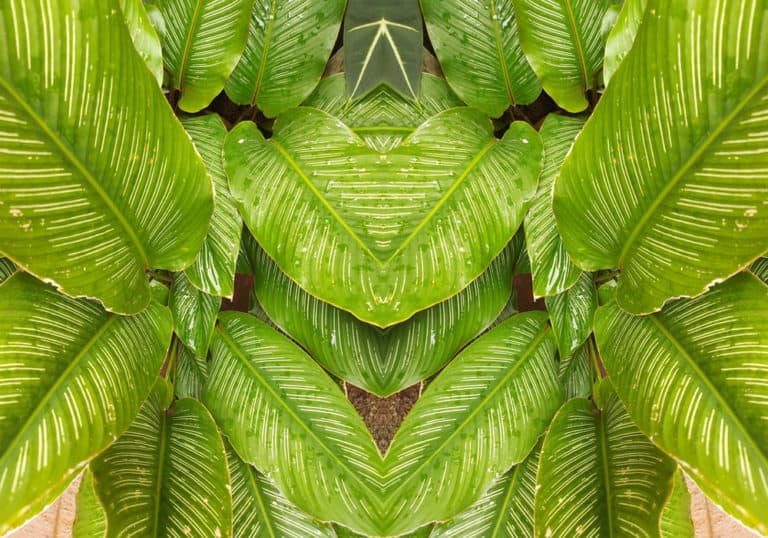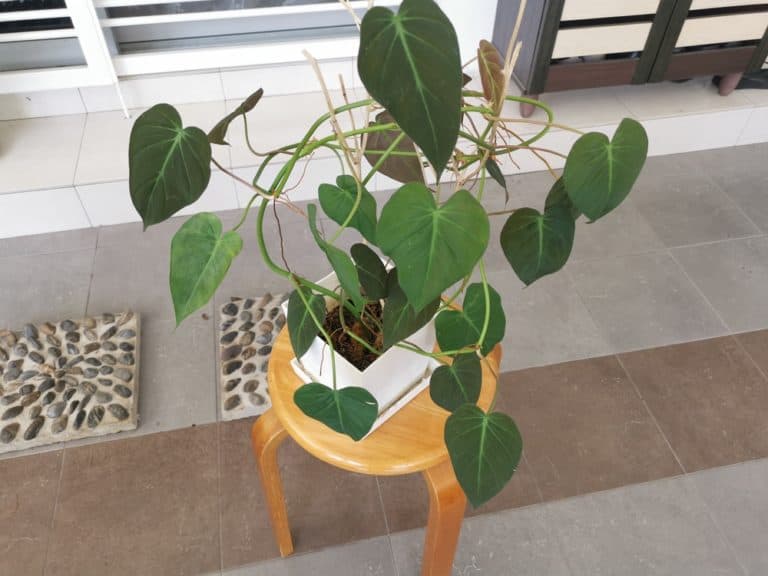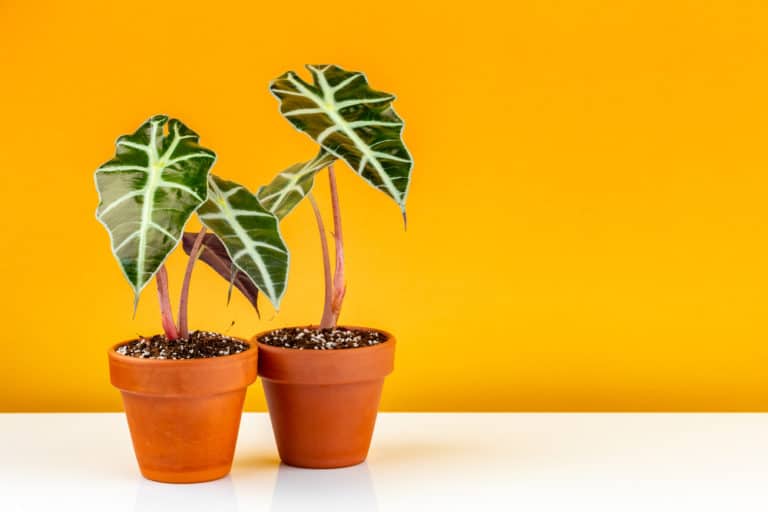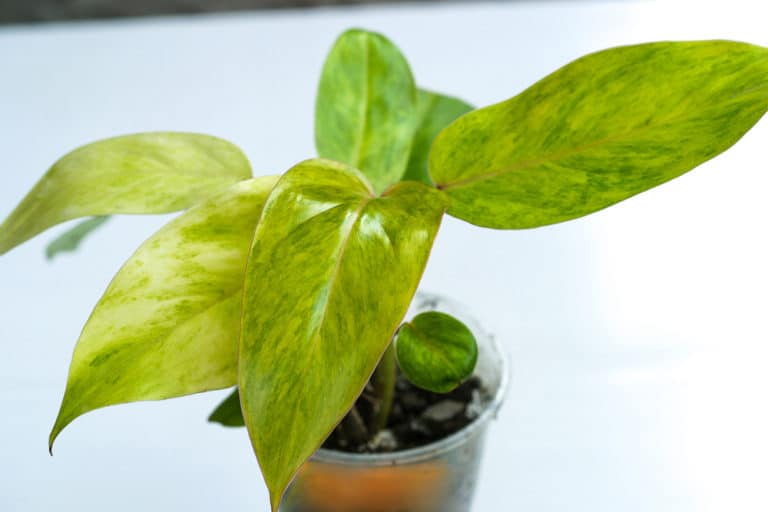Strelitzia Reginae ‘Bird of Paradise’ Care Guide (2024)
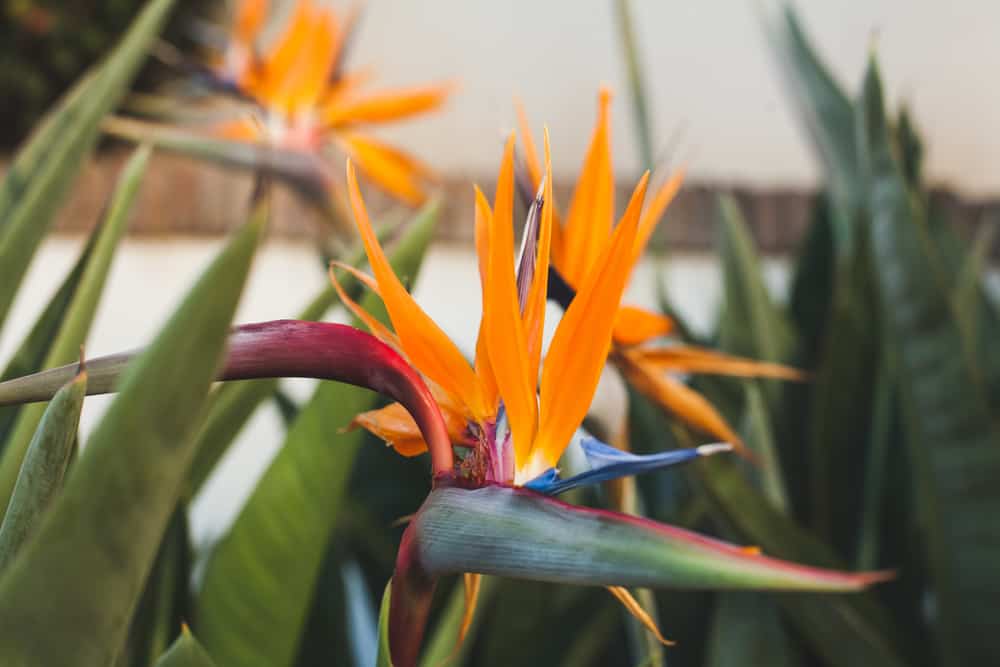
Bird of Paradise plant sounds like a fantastic name. And it is! This species, botanically known as Strelitzia reginae, is noteworthy for its flower that resembles the appearance of a tropical bird.
It’s a popular plant for the outdoors but one you can also successfully grow indoors. It’s generally easy to care for, too.
| Scientific Name | Strelitzia reginae |
| Common Name | Crane flower, Bird of Paradise |
| Light | Direct sun to low, indirect light |
| Watering | Every 1-2 weeks |
| Temperature | 55 to 60oF (10 to 16oC) range at night and 70oF (21oC) or warmer during the daytime |
| Hardiness Zone | Zones 10 to 12 |
| Humidity | At least 50% or more |
| Soil Type | Slightly acidic to neutral potting mix |
| Soil pH | Between pH 5.5 to 7.0 |
| Fertilizing | Balanced fertilizer that has equal parts of NPK |
| Repotting | Spring or summer is the ideal time for repotting |
| Pruning | Serious pruning should wait until early spring |
| Propagation | Root division is the simplest way to propagate a giant bird of paradise |
| Toxicity | Toxic to humans, cats, and dogs. |
| Mature Size | 5 to 6 feet tall |
| Bloom Time | Late winter to early spring |
What’s Unique About Bird of Paradise Plant?
What’s amazing about the Bird of Paradise plants is their unique flowers. Such a combination of bright orange and blue colored petals plus its close resemblance to the structure of a bird make this plant unusual. It has an ultimate symbol of paradise, freedom, and joy.
This species originates from South Africa, commonly known as a crane flower. Apart from being a beautiful ornamental piece, the Paradise plant flower is also a popular element in various flower arrangements. It’s considered a cut flower in the floral industry. Its large leaves, on the other hand, serve as a purifier that can remove toxins from the surrounding air.
Bird of Paradise Plant Care
Bird of Paradise plant care is considered easy and undemanding. This plant won’t give you serious trouble as it’s quite forgiving and tolerant of certain extreme conditions. However, you need to keep in mind that it also has specific requirements that should be met. Hence, pay close attention to the following tips on Paradise plant care.
Light
Full sun is the best condition to satisfy the Bird of Paradise plant light requirements. This gives the plant enough energy to grow and produce beautiful flowers. Although it prefers to have access to bright, indirect light, it can also thrive in medium light conditions. However, growth may not that be lush compared to when there’s plenty of direct light.
About 6 to 8 hours of sunlight with intensities ranging between 400 to 800-foot candles will be satisfying to the Paradise plant light needs. If you place this plant indoors, make sure it has enough access to proper light conditions. Use grow lights to serve as a supplementary source.
Watering
As far as watering needs are concerned, bear in mind that this plant doesn’t like staying in soggy soil. Hence, you have to wait until the substrate is completely dry before you water again. This could mean that you have to water Paradise plant once a week from Spring to Fall seasons. But once the winter arrives, this should be done less frequently.
Be cautious when it comes to Bird of Paradise plant watering, especially if planted indoors. There’s a very high chance that you overwater your plant because they’re contained in a pot with limited soil. Always remember to drain excess water.
Temperature
Generally, the favorable temperature for Paradise plant is something that’s warm. About 70oF (21oC) or warmer is preferred during the daytime. During the nighttime, it could fall between the range of 55 to 60oF (10 to 16oC). As much as possible, stay close to the ideal Bird of Paradise plant temperature range to avoid potential damage.
The temperature tolerance of this plant can only go as low as 50oF (10oC). Beyond that, your Bird of Paradise will show signs of stress and possibly acquire irreversible damage. For best climate conditions, it’s better to plant it in areas under USDA hardiness zones 10 to 12.
Humidity
It’s important that you maintain the ideal humidity for Paradise plant. This would help produce better growth and development. Be aware of the existing humidity level in the area where your plant is currently situated. It’s best if this humidity is at least 50% or more. You can monitor this using a digital hygrometer.
If the normal humidity goes down, that means that the environment feels a little drier. You would need to exert extra effort in adding in moisture. You could do that by simply misting water around your plant. This is a simple way to satisfy the Bird of Paradise plant humidity requirements.
Soil
There are two important things to remember when preparing the soil for Paradise plant. First, it must have a well-draining structure. Second, it must be rich in organic components. A well-draining soil mix will make it easier to lose excess moisture preventing root rot. Organic matter such as compost makes the Bird of Paradise plant soil fertile.
It’s also important to maintain the correct ph level for Paradise plant which is between pH 5.5 to 7.0 (slightly acidic to neutral). This allows the essential nutrients to be readily available for your plant to utilize. Poor soil will always lead to poor plant health.
Fertilizer
You should add Bird of Paradise plant fertilizer regularly because this plant is a heavy feeder. Apply a water-soluble fertilizer with a balanced NPK every two weeks during the active phase. This fertilizer ratio will help supply the nutrients that your plant needs. But make sure to dilute the solution so it won’t lead to fertilizer burns.
Refrain adding fertilizer for Paradise plant when the winter season comes. This is the time when the plant has very little activity (dormancy). Hence, your Paradise plant won’t need much of these nutrients. It’s highly important to strike a balance when it comes to fertilizer application.
Potting & Repotting
Choose an appropriate pot size depending on the current growth of your Bird of Paradise plant. If it’s about 3 to 4 feet in height, you can choose a 10-inch pot. If it’s about 5 to 6 feet tall, a 14-inch pot will do. You should do Bird of Paradise plant repotting every year or two during the Spring season.
As it reaches a mature size, you can stop repotting Paradise plant. This would allow the plant to generously produce blooms. However, once the roots start to seep out of the container, you may do potting again to replace depleted soil and give enough breathing room for the roots.
Pruning
Conduct Bird of Paradise plant pruning from time to time in order to keep the plant healthy. This is also a form of cleaning your plant from excess growth as well as damaged or diseased parts. You can also cut back the entire plant down to its base so it will rejuvenate as a whole. You may also trim some shoots that are growing.
Before cutting Paradise plant, always ensure that your shears are sanitized first. Make clean, slanting cuts so the wounds created won’t get infected by a disease. If the pruned part is diseased, discard it properly to avoid infecting the other plants.
Propagation
The plant has a clumping habit due to the presence of rhizomes underground. Hence, it’s best to propagate Paradise plant by dividing these rhizomes. But you have to remove the entire plant out of its pot to be able to cut it into sections. Make sure each division has a fan of leaves and healthy roots attached.
Plant each divided portion in a potting medium and water it thoroughly. You would know that the Bird of Paradise plant propagation is successful once you see new leaf growths forming. Provide an ideal growing condition until the newly propagated plants grow mature.
Common Problems of Bird of Paradise Plant
The majority of the Bird of Paradise plant problems that you’ll encounter will express signs and symptoms on the leaves. You may observe the foliage splitting, the edges browning, or the entire surface turning yellow. These are clear signs of underlying problems with the Paradise plant. Hence, it’s time to do further investigation to know the causes behind each one.
Pests
Apart from bugs, the other pests that could potentially bring trouble to your Paradise plant are snails, caterpillars, grasshoppers, aphids, and scale. These are pretty common among ornamental plants. You probably have encountered most of them.
Dealing with Bird of Paradise plant pests can be a challenge especially if you’ve allowed them to spread over. Hence, it’s always wise to prevent them from infesting your plant by making regular checkups. Inspect your plants and remove these pests once spotted. For the tiny pests, you may use cotton dipped in alcohol to swab them off. Spraying off with a solution containing insecticidal soap and neem oil will also help.
Diseases
There are four prominent Bird of Paradise plant diseases to watch out for. The most common is root rot, caused by a fungus that becomes active when the soil gets soggy for too long. The next one is southern bacterial wilt, caused by a soil-borne bacterium. The symptoms are almost the same as that of root rot.
Gray mold, which is caused by another fungus, can also affect your Paradise plant. This is more prominent if the moisture level in the surroundings is high. They can lead to discolored leaves and flowers. The last one is a fungal leaf spot caused by a fungus that causes the leaves to have yellow, brown, or black spots.
To prevent these diseases, always use a sterile potting mix as well as clean tools.
Growing Problems
There are many ways to determine if your Bird of Paradise is a sick plant or not. Although this species is normally tough, there are growing problems that it may encounter during the growth and development process. It may include problems with the leaves, top-heaviness, root rot, and failure to produce blooms.
Toxicity of Bird of Paradise Plant
The Paradise plant is undoubtedly a good addition to your outdoor or indoor gardens. However, remember that it’s toxic to humans (adults and children alike) as well as pets. Although the degree of toxicity is mild, it can still lead to serious health risks, especially if the amount ingested is high. Hence, careful handling is still necessary.
For Humans
Humans, whether adults or children, are both prone to mild toxicity caused by the Bird of Paradise plant. This could happen through ingestion of the stalks, leaves, or flowers. The most toxic part is the fruit which has the appearance of a pod, just like a legume. Gastrointestinal problems like vomiting and diarrhea could happen coupled with dizziness.
If accidental ingestion happens and such symptoms arise, make sure to seek medical help to prevent further health risks. For prevention, keep it away from the reach of your kids. Remember that they’re more vulnerable to suffering from toxicity because they’re always curious.
For Pets
If you have pets, you need to apply the same precaution when handling your Bird of Paradise plant. In the same way as humans, it has mild toxicity issues that could harm either your cats or dogs. Once consumed, problems like diarrhea, vomiting, and disorientation may happen to your furbabies.
The good thing is that your pets have a high chance of surviving the ordeal. But make sure to still consult your vet for proper medical advice. And as a way of prevention, better keep the plant away from your furbabies so they will not get harmed and vice versa.
Bird of Paradise plant Appearance
The Bird of Paradise plant appearance is easily distinguished by its crane flowers, a combination of orange and blue color resembling the shape of a bird. If flowers are not available, you will know this plant by looking at its erect and leathery green leaves that have an oblong shape.
Foliage
The foliage of Bird of Paradise plant has a close resemblance to that of a banana. It has an oblong shape with a distinguished midrib and a leathery feel when touched. The size, though, is smaller than that of a typical banana leaf.
Each leaf brings forth a tropical vibe and is also a showstopper. Hence even without flowers, the Bird of Paradise plant will stand out as a foliage plant. It needs full exposure to bright sunlight to remain lush and green. You can wipe those leaves off with a damp cloth to remove trapped dust when tended indoors.
Flowering
You’ll rarely witness a Bird of Paradise plant flowering indoors because of some limitations in the growing conditions. But outdoors, they bloom so well, especially if exposed to full sun. It will take about four years for a plant to mature and be ready for blooming. Juvenile plants won’t produce flowers so you have to wait.
Each flower grows directly from the rhizome with a stalk growing about 1 to 1.5 meters high. On top is the flower that has a bright orange and blue color. You can cut the stalk and put the flowers in a vase. They make a good element for flower arrangements.
Size and Growth
Depending on the prevailing conditions, the Bird of Paradise plant may have a slow to moderate growth rate. The first four years encompass its juvenile phase where the plant is still actively growing and developing to reach maturity. It’s during this time that you also constantly repot your plant to give it room to grow.
The typical size of Bird of Paradise plant is between 3 to 6 feet in height. But, they can always grow higher in the wild. Potted plants will relatively grow smaller due to limited space. If planted in the ground, they have the tendency to grow in clumps.
Bird of Paradise Plant Fragrance
As far as the Bird of Paradise plant fragrance is concerned, many gardeners said that it has that herbal or grassy scent. It will certainly provide a fresh and clean smell around your home. Those huge leaves are also good for cleaning up the air from toxins. Plus, the fragrance is not that strong, which is good if you have a sensitive smell.
Outdoors, it may be hard to distinguish its own scent, especially when combined with other plants in a garden. But the attractive flowers will ultimately draw the attention of many pollinators like bees, butterflies, and other insects.
Suggested Uses for Bird of Paradise Plant
You can plant a Bird of Paradise indoors primarily as a foliage plant. Its tall and leafy appearance will be perfect for achieving a tropical look. It will do well in areas with a bright light just like near a glassy window. It’s also good for air purification.
You can also utilize Bird of Paradise as an outdoor plant. You can use it as an accent in a landscape or a hedgerow because it can easily spread in clumps. They are tough and hardy so they’ll do well as an outdoor plant. You can harvest the flowers, put them in a vase and use them as a decoration.
FAQ
What is Bird of Paradise plant?
The Bird of Paradise (Strelitzia reginae) is an evergreen plant that’s native to the Cape Provinces of South Africa. It’s widely known for its unique flowers resembling a forest bird.
How to identify Bird of Paradise plant?
This perennial plant grows in a clump. Its leaves are waxy and gray-green in appearance similar to that of a banana. The flowers have orange bracts and indigo petals.
How to care for Bird of Paradise plant?
When growing Bird of Paradise plant, provide lots of light, water, and humidity to keep this plant happy. Also, make sure that you use well-draining soil like a loam-based potting mix.
How to grow Bird of Paradise plant indoors?
You can grow Bird of Paradise indoors by placing it in an area where there’s enough light, warm temperature, and high humidity. Give it plenty of room as it can grow tall and wide.
How to grow Bird of Paradise plant outdoors?
The plant will do well outdoors if planted under full sun. Keep the soil moist by regular watering. And make sure that the place has high humidity, too.
How fast does Bird of Paradise plant grow?
Bird of Paradise is a fast-growing plant. It can easily spread too because of its clumping habit. It will take about five years for it to reach maturity and be ready to bear flowers.
How tall does Bird of Paradise plant grow?
When mature, a single Bird of Paradise plant will reach an average height of 5 to 6 feet and a width of about 4 feet.
How to make Bird of Paradise plant grow faster?
Bird of Paradise is already a fast-growing species. But they can easily experience nutrient deficiency. Hence, in order to support fast growth, you must regularly fertilize this plant.
How to stake Bird of Paradise plant?
There’s no need to stake the Bird of Paradise because this plant has stems that grow erect. Those stems are strong enough to hold up the foliage and flowers.
How to pot Bird of Paradise plant?
Use a loam-based potting mix with plenty of compost to keep it fertile. Prepare a planter that has enough drainage holes and pot your plant there using the potting mix.
How to revive Bird of Paradise plant?
If the signs showed involve watering problems, adjust the watering frequency. If it’s caused by light, adjust the lighting. If humidity, make ways to improve humidity.
Why is my Bird of Paradise plant dying?
Check for signs of root rot. This is the most common reason why Bird of Paradise dies. If you notice rotting roots, trim them down and repot your plant using a new potting mix.
Why is my Bird of Paradise plant drooping?
This could be due to underwatering. Dehydration can cause the leaves to shrink and curl. If the soil is totally dry, give it a thorough watering.
How cold can Bird of Paradise plant tolerate?
It can tolerate as low as 50oF (10oC). Freezing temperatures will cause irreversible damage to the leaves and flowers. You can move the plant indoors from the outside once it gets really cold.
How to get rid of pests on Bird of Paradise plant?
Manually pick the large pests. But for those that are small, spray a solution containing insecticidal soap or neem oil. You may also rub them off with cotton dipped in alcohol.
Is Bird of Paradise plant toxic to cats?
Yes, it is mildly toxic to cats if ingested. So, you need to get a little more cautious. Place it somewhere your cats won’t frequently reach.
Is Bird of Paradise plant toxic to dogs?
Yes. This species is also mildly toxic to dogs. Once ingested, it could lead to serious gastrointestinal problems. So, keep your furbabies away from a Bird of Paradise plant.
Is Bird of Paradise plant toxic to children?
Children are also susceptible to the toxicity of Bird of Paradise. Once ingested, it could result in a certain discomfort in the GI tract such as vomiting and diarrhea.
Is Bird of Paradise plant toxic to humans?
Even adult humans are also susceptible to mild toxicity brought about by the Bird of Paradise. So for safety, make sure not to ingest any portion of this plant.
Does Bird of Paradise plant have a scent?
Yes. It has an herbal and grassy scent. The fragrance is light and airy. Thus, it won’t create problems for those having a sensitive smell.

